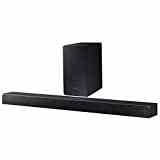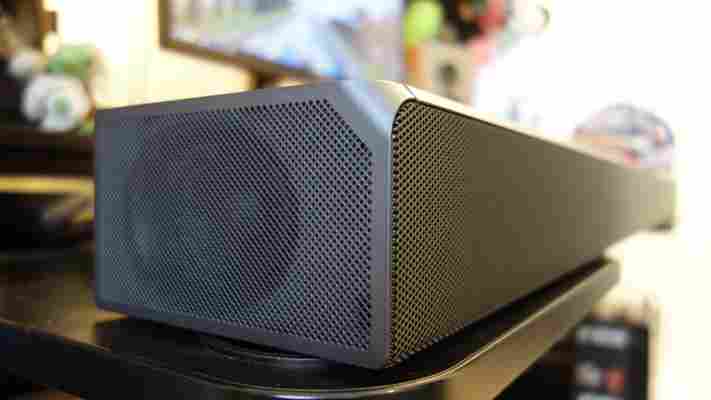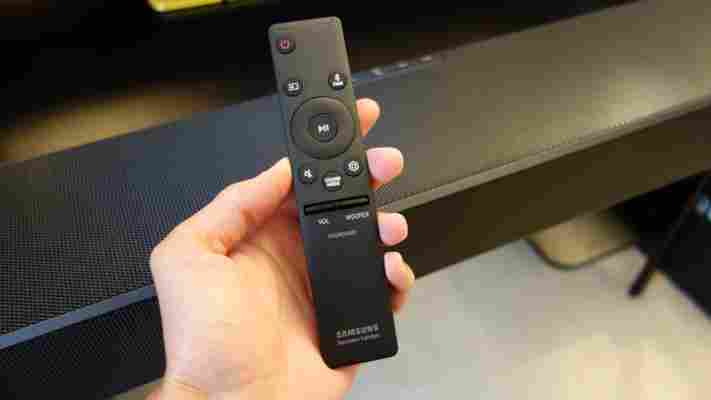In the past few years, Samsung has come up with some clever new audio technologies for its soundbars. The HW-MS650 model introduced a distortion-cancelling feature which delivers a tighter low-end response, while the more recent HW-N650 uses acoustic beam technology to bounce sound waves around your room for a surround sound effect.
With the HW-N850, however, the focus is squarely on sound quality. The company has partnered with audio specialists Harman Kardon to produce a tempting alternative to Samsung’s current flagship soundbar, the HW-K950.
READ NEXT: Samsung HW-K950 review: Fantastic surround sound – at a price
Samsung HW-N850 review: What you need to know
The HW-N850 uses a whopping 13 drivers, spread across two upward and two sideways-firing speakers, plus a wireless subwoofer. That gives it plenty of punch and volume, and lots of scope for directional sound.
Unlike the K950, it also supports both DTS:X and Dolby Atmos, delivering immersive cinema-quality audio from Blu-ray discs that take advantage of these technologies. There’s one other notable difference between this and the K950, though: the HW-N850 package doesn’t include rear speakers.
READ NEXT: Best soundbars: Our favourite TV speakers
Samsung HW-N850 review: Price and competition
At £1,100, the HW-N850 is just as expensive as the K950 . There are much cheaper Dolby Atmos-enabled rivals out there, such as the LG SJ9 and the fully fledged Onkyo HT-S5805 system , which both cost £620.
If you don’t need Dolby Atmos, Samsung’s own £700 HW-N650 is also worth looking at, while the impressive but subwoofer-less HW-MS750 costs just £500 . You can add a separate subwoofer, but it costs £362 , so the HW-N650 might be a better deal overall.


Samsung HW-N850 review: Design, features and connectivity
The N850 is a sizeable thing, measuring 123cm long by 13.6cm deep and 8.3cm high. That makes it a tad larger than the K950, so check before you buy that it will actually fit on your cabinet. Alternatively, you can attach it on a wall with the bundled mounting kit. I don’t recommend you tuck it away in an enclosure, however: the sound from the upward and sideways-firing speakers needs to reverberate around your living room to achieve the proper sonic effect.

Design-wise, the N850 shares a lot of characteristics with its siblings, with a metal speaker grille that extends all the way around the casing. There are four physical buttons on the top for power, input source and volume, plus a well designed remote control that provides access to all of the soundbar’s settings.

Like other Samsung soundbars, the N850 is easy to set up and offers a comprehensive array of connectivity options. If you own a Samsung Smart TV, such as the excellent Q9FN , you can even connect it to the soundbar wirelessly. Physical ports include two HDCP 2.2-compliant HDMI 2.0 inputs, one TV-ARC HDMI output (which supports HDR, 3D and 4K video passthrough) and an optical input. There’s Bluetooth too, so you can play music from your smartphone, although Bluetooth aptX isn’t supported – and, oddly, Samsung’s Multiroom App isn’t either.
On the plus side, the N850 does integrate with the SmartThings app (like the Q9FN ), which means you can integrate the soundbar with other connected Samsung devices.
Just be aware that there’s also no 3.5mm headphone jack, nor any USB ports for media playback. There is a USB port on the underside, but that’s for servicing purposes only.
READ NEXT: Samsung HW-MS650 review: The innovative soundbar with distortion cancelling technology
Samsung HW-N850 review: Sound quality
The N850 features two drivers at each corner of the soundbar, and another two on the left and right-hand sides. These are larger than the drivers on the K950, and Samsung claims that this configuration removes the need for separate rear units. That makes the whole setup admirably simple, and it’s especially good news since my colleague Jon found the rear speakers on the K950 to be temperamental .
If you do want to add rear speakers, you can pair the Samsung SWA-S9000S , which cost an additional £90 – but that shouldn’t be necessary. As a fan of surround sound systems, I was amazed by the N850’s ability to produce directional audio without rear or ceiling-mounted speakers. DTS:X and Dolby Atmos-enabled media deliver an incredible experience: at one point in Transformers: Age of Extinction a helicopter flies overhead, and it was as if the aircraft was in my living room.
Even from regular audio sources, the N850 produces an incredibly wide and deep soundstage, with excellent instrument separation and positioning. From the low-end rumble and precise mid-bass slam of the wireless subwoofer to pitch-perfect mid-range tones and beautifully extended highs, it all sounds superb – better than any other soundbar I’ve tried, in fact. The partnership Samsung has struck with Harman Kardon has really paid off.
I should mention that it’s all good and loud, too. The N850 has a total RMS power of 372W, which is a fair bit lower than the K950’s 500W – but it’s still more than ample for any living room. I actually found it uncomfortably loud to turn the volume up past the 25% mark. Simply put, the N850 has what it takes to provide a fully immersive, cinematic experience.
READ NEXT: Samsung HW-N650 review: Surround sound without the hassle
Samsung HW-N850 review: Verdict
The N850 is a brilliant audio system. Sure, it’s expensive, and you might be uncertain about the lack of rear speakers. But once you hear it, you’ll have no qualms about either.
Indeed, with the inclusion of DTS:X and Dolby Atmos, you really can enjoy your films at home just as if you were in the cinema, and the fact that you don’t need to faff around with rear or ceiling-mounted speakers only adds to its appeal. Right now there’s nothing out there to better it, and that includes Samsung’s own supposedly top-tier K950.